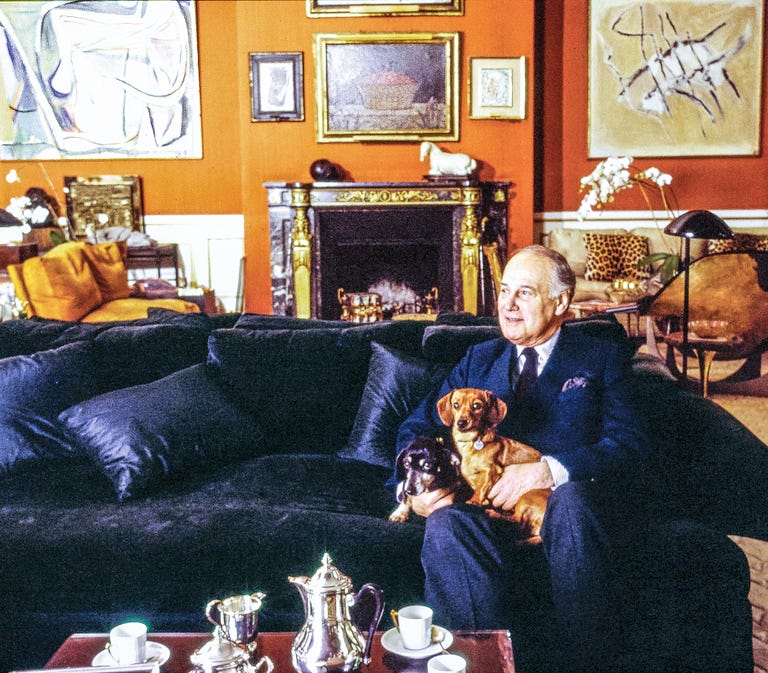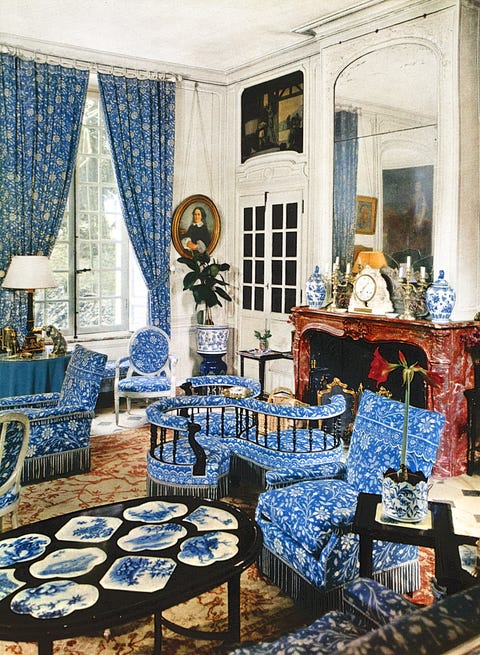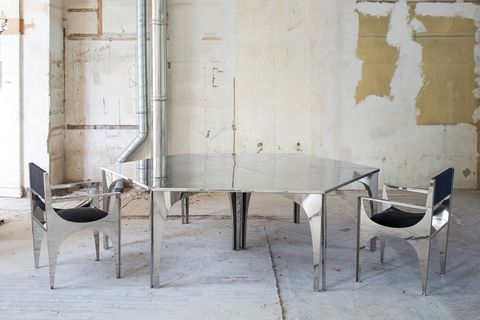
I first became aware of the work of French designer Henri Samuel in the mid-1980s, in what might be called his robber baron phase. At that heady time in American social history there were a few decorators from England and Europe working in New York for very visible clients: Geoffrey Bennison had just performed miracles for Guy and Marie-Hélène de Rothschild on East 66th Street, and Henri Samuel and his project for Susan and John Gutfreund at 834 Fifth Avenue were the talk of the town.
Before then the apotheosis of Reagan-era classical style had been basically Georgian. Afterward a gap was bridged, and it was said that Samuel’s work didn’t just evoke the past, it was as good as anything in that past. Samuel delivered to the New World something that was thought to be no longer possible: the authentic opulence of another continent and another time.
Later I learned the missing pieces of the Samuel story. This happened, as it often does, in the form of an auction catalog. The Christie’s Monaco sale after his death in 1996 contained many avant-garde works of contemporary “art furniture,” as well as pictures of his Paris apartment that were positively bohemian— luxurious, yes, but very artistic. You must remember that this was before that apartment was well known, and images were not just waiting for you on the internet. One had to research, save magazines, connect dots. It was a revelation how Samuel had lived at home, with contemporary art and zany furniture, and it was hard to square this with his work for the second Gilded Age.
Emily Evans Eerdmans’s new Rizzoli book, Henri Samuel: Master of the French Interior($75), is a long time coming. Samuel’s reputation has been growing steadily, and it’s amazing there has been no book until now. Which Samuel will you like best? There is one for every era. He worked in many styles, but what he stood for consistently was quality. Jacques Grange, who worked for Samuel early in his career and wrote the foreword, described to me an office environment that was very formal and hierarchical. But, he added with great respect, “that is where I learned what quality is.”
Excerpted here are passages that explore Samuel’s influence on younger designers today; his collaborations with such artists as Balthus, Philippe Hiquily, and Guy de Rougemont; and his work for American plutocrats like the Gutfreunds (on Fifth Avenue) and Jerry Perenchio (in the house made famous by the title sequence of The Beverly Hillbillies). If you like what you see (and have had a good year), both properties are, coincidentally and for the first time in decades, now for sale. But start with the book.
Henri Samuel mixed the contemporary with the classical to thrilling effect. Throughout his career the decorator proclaimed there was no “Samuel style” but that each project evolved from the client’s taste. “I remember seeing images in the 1990s, in a Christie’s auction catalog, of Henri Samuel’s iconoclastic Paris apartment,” says Delphine Krakoff of Pamplemousse Design in New York City.
Like Samuel she often pairs a classically articulated room with experimental pieces, so that it looks as if it has been furnished over time. “It was filled with artwork and furniture by Balthus, Atlan, César, and Hiquily, combined with cutting-edge contemporary as well as neoclassical design. I was taken by his unexpected and fearless commitment to a unique vision, his understanding of history and of design and architecture, without being constrained by it. History is just a point of departure in his design process.”
In 1970, after 25 years as head of the design firm Alavoine, Samuel began a new chapter in his career: Henri Samuel, décorateur. He opened his own firm, prompted not by ambition or a desire to have his name at the forefront but because Alavoine had finally closed its doors. At 66 the designer was internationally acclaimed as a master of French decoration, and kings of both countries and industry clamored for his time. Samuel set up shop on the ground floor of his apartment building at 83 Quai d’Orsay and maintained a small staff to oversee all projects.
In addition to Madame Chaminade, his secretary, and Jacqueline Lallemand, his accountant, there were Jacques Cayron and a Monsieur Hanché, who were his design associates. There was also a full-time draftsman. When Samuel moved to 118 Rue Faubourg Saint-Honoré, around 1976, the staff worked out of a small office in his apartment, where a minuscule stairway led up to a drawing studio.
“Pierre, a tiny man who drew incredibly in the style of Louis XV, Louis XVI, and Empire, drafted the plans for everyone,” recalled the architect Christian Magot-Cuvrû, who began working with Samuel in the early 1980s. The work was intense, but the office was run with civility.
Every day Samuel would have lunch at Maxim’s or Le Relais at the Plaza Athénée, often dining with friends such as the Duchess of Windsor. “Tea-time at Monsieur Samuel’s was very important. Around 4:30 p.m. his majordomo would come to serve us tea, and it was during this moment of pleasant relaxation when we spoke of everything and nothing for 30 minutes,” Magot-Cuvrû remembers.





